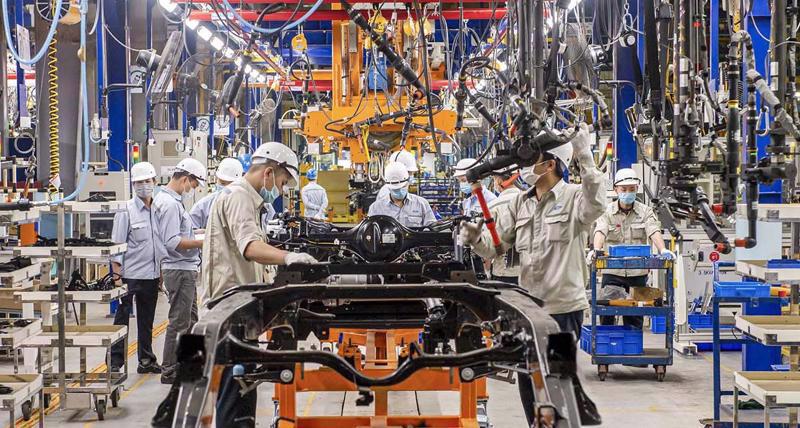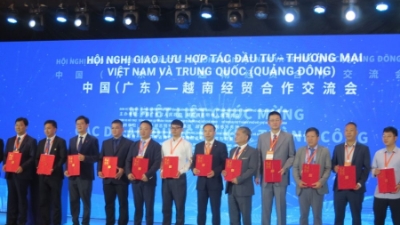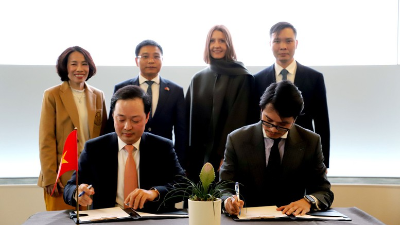Manufacturing has been at the epicenter of Vietnam’s high growth over the past decade, contributing more than 20 per cent of GDP and being an anchor in the country’s trade balance while helping attract FDI. It played a significant role in the remarkable resilience Vietnam’s economy demonstrated in the face of global upheaval, and maintained GDP growth of 2.6 per cent in 2021 amid Covid-19 and then posted 8 per cent in 2022. This resilience is also testament to the country’s robust control measures and strategic economic planning.
A unique combination of several key advantages has made Vietnam a prime destination for international investment, especially in labor-intensive manufacturing. These include the relatively low cost of labor, appropriate infrastructure to support exports, and Vietnam’s strategic location straddling major trade routes. Government measures at the national and provincial levels, such as corporate income tax breaks for high-tech companies or specific fit-for-purpose industrial parks, have also helped.
Vietnam continues to be an attractive location for supply chain diversification. Its status is supported by the trade benefits that the government has established in recent years. Besides being members of the WTO and ASEAN, Vietnam has also entered into 15 free trade agreements with partners across all continents, including strategically-important partnerships such as the EU-Vietnam Free Trade Agreement (EUVFTA) and the Comprehensive and Progressive Agreement for Trans-Pacific Partnership (CPTPP), all of which favor lower trade tariffs to boost trade value.
Clouds on the horizon
However, 2023 brings its fair share of challenges and opportunities. Inflation, geopolitical complications, a gloomy economic outlook for several of Vietnam’s trading partners, and technological advancements that all manufacturing locations have to keep pace with mean that its strength in providing low-cost labor may not have as much of an edge as previously.
Reduced demand from Vietnam’s key trade partners and tightened monetary policies have also affected the rising Asian “tiger”. The export of goods in the first five months of 2023, for instance, declined 12.3 per cent compared to the same period last year. In addition, structural and deeper fundamental challenges call into question the ability of Vietnam to keep expanding its manufacturing base and attract investment. The sector currently faces four challenges.
First, while workplace productivity has gradually improved over recent years, it remains behind some of Vietnam’s Asian peers. As of 2021, Vietnam ranked 136th out of 185 countries and territories in workplace productivity. One reason for this is that the relatively lower labor costs Vietnam banked on have increased as the country developed and as the workforce pool that could be mobilized started to shrink. Alternative destinations such as Cambodia, Myanmar, and Bangladesh have been put on the table by investors when considering their next investment, where labor cost is a top priority.
Second, despite an increase in the manufacturing sector’s export and FDI value, the value captured locally has yet to increase correspondingly. In simple terms, Vietnam manufactures more over time but does not increase the share of added value captured in the country. So, despite the manufacturing sector’s growing contribution to the overall economy, the value added by this sector remains flat and even decreased by 0.37 per cent in 2023 compared with the same period of 2022. This is also linked to a fragmented supply chain in several other industries, and Vietnam remains an import-dependent exporter.
Third, although Vietnam has done a lot to improve the “ease of doing business”, investors highlight lingering concerns that may prevent them from continuing to invest, especially in high-value-added, high-tech industries. These concerns range from a shortage of skilled workers for research and development or technical activities to issues with language efficiency, potential uncertainty relating to labor rights, and onerous applications that expatriates who want to work in Vietnam must make.
Fourth, various conditions that arose in 2023 seem to have also impacted the overall confidence of investors. Long-term energy security has yet to be established; an uncertainty that was exacerbated by power cuts in the country’s northern industrial parks. This, along with a lack of clarity over future tax benefits, has led prospective investors to question the viability of Vietnam’s growth trajectory, which could impact the country’s brand. In the first seven months of 2023, Vietnam’s FDI inflows were roughly equal to those in the same period the previous year (plus 0.8 per cent).
Transforming the manufacturing sector
The competitive advantage Vietnam holds as a manufacturing destination is not likely to erode overnight, but the hiccups that surfaced in 2023 highlight the need to shift from being positioned as a cost-effective to a productive manufacturing destination. Efforts from stakeholders can focus on a single “North Star”: maximizing output per worker in the manufacturing sector. This would require orchestrated cooperation between the public and private sectors. While the Vietnamese Government has continually enabled such efforts, they need to be effectively cascaded down to the provincial and industrial-park level with simplified processes.
Meanwhile, the government has consistently set ambitious targets for the manufacturing sector. It is expected to contribute 30 per cent to overall GDP, of which high-tech products should comprise at least 45 per cent. The sector’s contribution to GDP should grow by more than 8.5 per cent per annum, and workplace productivity should grow 7.5 per cent per annum. This ambition is not new. In fact, authorities have been focusing consistently on manufacturing for years, investing in infrastructure and facilitating foreign investment for that purpose.
Several conditions will need to happen at the same time to unlock progress toward this goal. These include prioritizing and promoting industrial upgrading in manufacturing sub-sectors where Vietnam has stronger competitive advantages. The government could also cultivate supporting industries by incubating businesses that have the potential to become the backbone of the manufacturing sector, such as spare parts, specialized supporting equipment, and software.
Upskilling the workforce is another factor. This should be a joint effort between the government, trade associations, industry leaders, and educational institutions. Based on best practices seen in other countries in the region, this multi-pronged approach is one of the most efficient ways to ensure that programs are relevant and practical. Finally, it could be worth exploring private investments to enhance productivity.
What private manufacturers can do
For existing or prospective investors in Vietnam, one of the most top-of-mind questions is how can they get the best out of their Vietnam operations. We believe manufacturers can still benefit from favorable workplace competitiveness and, on top of that, apply different approaches to optimize operations. Based on the current state of manufacturing in Vietnam, here are five domains that leaders could prioritize.
Firstly, use simple, proven digital tools and analytics solutions for process optimization. For a manufacturing landscape as labor-intensive as Vietnam’s, using data to inform decision-making can help ease three perennial challenges: daily workforce attendance, above-average turnover, and skill mismatches.
Secondly, selectively invest in upgrades for flexible automation. Beyond optimizing current processes to increase productivity, manufacturers can also invest in automating physical manufacturing itself.
Thirdly, build supply chain resilience. Vulnerability in the supply chain has heavily impacted companies globally, and Vietnam has been no exception, especially because it relies on imported materials for the production of key exports such as cell phones, computers, and electronics peripherals.
Fourthly, invest in upskilling talent. As manufacturers increasingly produce sophisticated end products, and as they implement process excellence, digitization, and automation, the need for skilled labor will increase.
Fifthly, strategize the transformation. Only about 20 per cent of organizations in our recent survey reported high levels of success in driving transformation. To succeed, transformation plans must meet three conditions. First, they need to be value-backed, meaning organizations should prioritize use cases that generate the most savings and which help create and sustain momentum in execution. Second, they need a structured implementation road map that is broadly communicated to stakeholders in the company to help break silos and that spans strategy, talent, operating model, technology, data infrastructure, and analytics to enable adoption and effective scaling. Third, they need to be supported by a strict cadence of project review, measurement, and feedback loops to keep transformation plans on track.
Recent falls in FDI and exports in 2023 present an opportunity for Vietnam to rethink its position in the global context and act. The country is at a crossroads. It faces structural challenges yet continues to attract significant FDI that could fund a transition to a more productive manufacturing sector.
(*) McKinsey experts are: Matthieu Francois (Partner in McKinsey’s Ho Chi Minh City office, Thomas Hansmann (Partner in McKinsey’s Jakarta office, Bo Huang (Associate Partner in McKinsey’s Singapore office), and Zoey Nguyen (alumna of McKinsey’s Hanoi office).









 Google translate
Google translate